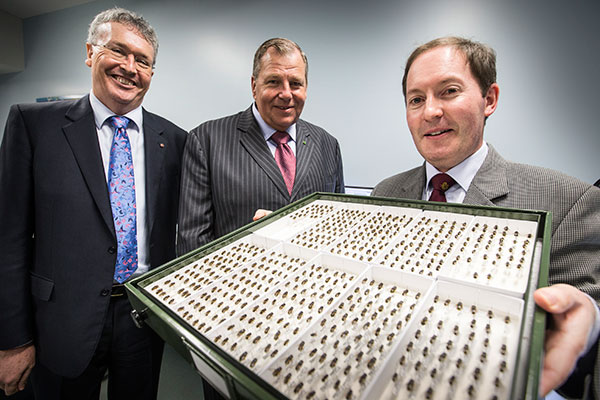April 21, 2015
Flesh flies and forensic science – research gets gory
Solving gory crimes is about to get quicker, if ‘flesh fly’ researchers from UOW have their way.

Vice-Chancellor Professor Paul Wellings (left), The Hon Bob Baldwin and Associate Professor James Wallman, looking over a collection of flies.
Through an Australian Government science grant, they’re working on a set of tools to help identify the type of maggots found infesting dead bodies, assisting police with important details of the death of murder victims. The work will be done in collaboration with fly scientists from Denmark and Poland.
This nature discovery job with a grim slant is just one of 21 projects kicking off, through a $2 million package of National Taxonomy Research Grants. It brings this Government’s investment in the grants to $5.3 million so far.
Project leader Associate Professor James Wallman, from the School of Biological Sciences, said the grant would enable researchers to identify more types of flesh flies from across Australia that are not well understood or identified.
"This will enhancing understanding of biodiversity of flies in Australia and particularly inland Australia," Professor Wallman said.
"There's one particular group of flies we know about that has been recognised only a few times by scientists in terms of formal naming and we think there could be dozens more out there that are completely undescribed."
Parliamentary Secretary for the Environment, Bob Baldwin, said the $105,000 flesh fly grant for the UOW shows how fundamental ‘taxonomy’ – the science of identifying species – is to everyday life.
“There are likely to be more than 150 species of flesh flies in Australia and each species provides different clues about the time and place of death. When speed is of the essence, narrowing down the exact species collected by police from a crime scene can take precious time,” Mr Baldwin said.
Through this taxonomy grant, the researchers will be looking for better and quicker ways to identify immature and adult flesh flies, using methods based on their physical appearance, as well as their DNA.
The team will be enhancing an existing DNA database for flesh flies, filling crucial gaps in our existing knowledge of their evolution as well as their identity.
Alongside the practical applications, this project has a strong nature discovery focus. The researchers will be scouring parts of Australia, particularly in Queensland, the Northern Territory and Western Australia, for a little known sub-group of flesh flies that parasitise other insects.
This sub-group may also have forensic value in investigating buried remains, to which some species are attracted.
“The team is almost certain to discover dozens of flesh flies that are completely new to science – extremely exciting stuff," Mr Baldwin said.
“The benefits from this kind of targeted research are huge – we support young scientists, build our knowledge of native species, and the real-world uses speak for themselves.
“You need this basic biodiversity knowledge to drive all sorts of real-world solutions, from forensic science and health care, through to commercial fishing and tourism.”
The National Taxonomy Research Grant Programme has been running since 1973 and is Australia’s national source of funding for this essential area of science.
Media contact: Grant Reynolds, Media Communications Officer, +61 417 010 350 or grantr@uow.edu.au.


